Learning the hard way
I remember buying my first pair of walking boots long before the days of the internet. Armed with knowledge of the “best in test” from the latest walking magazine I headed out to a local outdoors shop and just bought them.
I’m not a fool, I did try them on in the shop, they felt ok – however, being my first pair of walking boots I didn’t know what they should feel like, but I was confident that they would be good as they were “best in test”! I parted with my hard earned cash and left the store with my new boots in a bag with dreams of long days exploring mountains as per the articles in the same magazine.
BUT on the first day out the boots crippled me! I got the biggest and most painful blisters ever. I assumed they needed “breaking in” so I wore them for small local walks, but I suffered blisters every time. I tried everything, different socks, two pairs of socks, different lacing techniques, vaseline, strapping, but no difference! I eventually gave up and went to another outdoor shop, one with a boot fitting service.
I entered this shop armed with my boots and explained the situation to an assistant. We walked to the boot section, but rather than trying on other boots the assistant asked me a load of questions including but not limited to…..
- What type of hiking are you planning to do with these boots?
- Where are you going to hike?
- When are you looking to hike, between what months?
- Are you going to do single day hiking or looking to do multi-day hiking?
- Do you want to hike steep mountains and maybe a bit of scrambling?
After answering these questions the assistant had a good look at my feet and proceeded to measure them whilst I was sitting down and then standing up.
Lesson One, what I thought was my shoe size is not my shoe size! Yeah, the original boots I bought were the wrong size!
Lesson Two, my foot has a specific shape and boots have a specific shape called a “last” and each manufacturer have slightly different lasts. Therefore, we needed to match my foot shape to the manufacturers last. Yeah, the boots I bought did not suit my foot shape!
Lesson Three, there are hiking boots for different seasons, conditions and uses. Yeah, the boots I bought were not suitable for what I wanted to do!
Armed with the knowledge of my intended mountains adventures, my foot shape and size the assistant disappeared into the back and re-appeared with a tower of boot boxes.
First pair were unboxed, not to try on but the insoles were removed and I was asked to stand on them whilst the assistant checked my feet on each insole, this was repeated with several other boot insoles…..
After the insole test we dismissed a number of pairs and I eventually got to try on the remaining boots. Wow what a difference in fit and feel compared to those things I bought! However, the assistant was still not finished we had to do more tests to make sure they were the right boot:
- Walk around the shop a few times, go up and down the stairs, how do they feel?
- Now onto the slope, walk up the slope any heel lift or rubbing?
- Face down the slope and stomp your feet, have your feet moved down the boot or are your toes touching the front of the boots?
- Onto the rock bed now, how do the rocks feel on your feet, can you feel them through the soles of the boots?
Finally the end result, boots that fitted perfectly and designed for my planned hiking adventures. These boots fitted like a glove, they never gave me blisters or any other problems and allowed me to hike with confidence in UK and overseas mountains.
In over 30 years of hiking I have bought plenty of boots from the same manufacturer and other manufacturers. Despite my experience I still get my feet measured and have a chat through my requirements with the shop assistant. It’s worth it as my feet size have changed twice over the years, they also know their boot range and how boots have changed over the years.
Reviews & Recommendations
Magazine and internet reviews are a helpful guide with regards to what boots are available on the market, what they are suitable for, composition, weight and quality. But remember that a “best in test” boot may not suit your foot shape or intended activity.
I would advise against asking for recommendations on social media, whilst respondents will always answer in good faith based on their own experience and foot shape that boot “x” are excellent those boots may not suit your feet or intended activity. Also the high number of responses identifying different boots will create a confused picture and potentially set an incorrect level of expectation if you go to an outdoors shop to be fitted for boots.
Personally I would never recommend a particular boot make or model as this is dependent on matching an individual’s foot size and shape to a boot last. However, I would offer advice on the suitability of a boot for certain activities. My recommendation will always start with :- go to a reputable outdoor shop for assessment and a fitting and let them guide you to the right type of boot.
Buying Online?
Most of us enjoy the convenience of shopping online so why not buy your boots online?
If you live miles away from a decent outdoor shop and you know what model/make suits you through previous fittings then it shouldn’t be a problem. However, I would make sure that it is a reputable site and they have a returns policy on the off chance that the boots don’t fit.
If these are your first pair of boots then I recommend avoid buying online and make the effort to go to a good outdoor shop and get boots professionally fitted. In addition if you are looking to change activities from summer walking to winter walking I would suggest that you go for a professional fitting as winter boots are very different to summer boots.
I would also encourage people to support their local shops where they can, many provide a great boot fitting service and will often price match or provide a discount. Some have an online presence that I would consider using before a faceless website.
Footwear Types
There are four gradings applied to hiking boots and shoes commonly found in outdoor shops, B0 through to B3, each are described below:
- B0 – a flexible sole boot/shoe typically used over the summer months.
- B1 – the first level of stiff sole boots, good for occasional winter walking when used with a C1 Crampon.
- B2 – the second level of stiff sole boots, compatible with C1 and C2 Crampons. Good for winter days in the UK mountains as they can easily handle front pointing and kicking in steps.
- B3 – the third level of stiff sole boots compatible with C1 to C3 Crampons, suitable for more advanced and technical winter days in the UK mountains including ice climbing.
For the majority of people a good quality B0 rated boot would be suitable for UK Hills and Mountains, these can be used all year round (up to the snow line) and will provide good support and protection.
In addition to the questions asked by the shop assistant here are some other considerations you need to think about when choosing your footwear:
- Upper material – choices include leather, cloth or synthetic – this is a personal choice along with colour and style! That said leather will offer more protection and will last longer when cared for properly, cloth and synthetic are often lighter but may not offer the same protection and longevity as leather.
- Waterproof lining – either Gore Tex, Event or manufacturers own make. All synthetic/cloth boots should have a waterproof lining to protect your feet from the UK weather. As leather provides better weather protection some boots come with waterproof linings for added security whilst others don’t. For leather I would say that a waterproof lining is optional and down to personal preference, some find a waterproof lining makes their feet too hot.
- Sole unit – Vibram is a common make used by manufacturers however some use their own design. Questions to ask yourself include is it stiff enough and does it have an appropriate lug pattern (tread) for your intended use? To test the boot stiffness try to bend the boot from front to back, the harder it is to bend the stiffer the boot.
- Protective rand – is a rubber strip around the boot just above the sole unit which provides additional protection to the boot, useful in steep rocky terrain and in snow.
Below are some typical hiking footwear available in UK shops, I have included their boot rating, pros/cons and my thoughts of suitable use and what to look for when purchasing.

Approach Shoes/Cross Trainers (B0)
Many makes and models available, with a mixture of cloth or suede uppers and some having a waterproof lining for added protection. Sole units can either be Vibram or own design and offer differing levels of grip on different surfaces depending on the intended purpose of the shoe.
Ideal for low level walks on good tracks that are not too wet or muddy.
Pros – light, flexible, comfortable from the box.
Cons – no ankle support, low cut will allow water mud/water to easily enter the shoe.
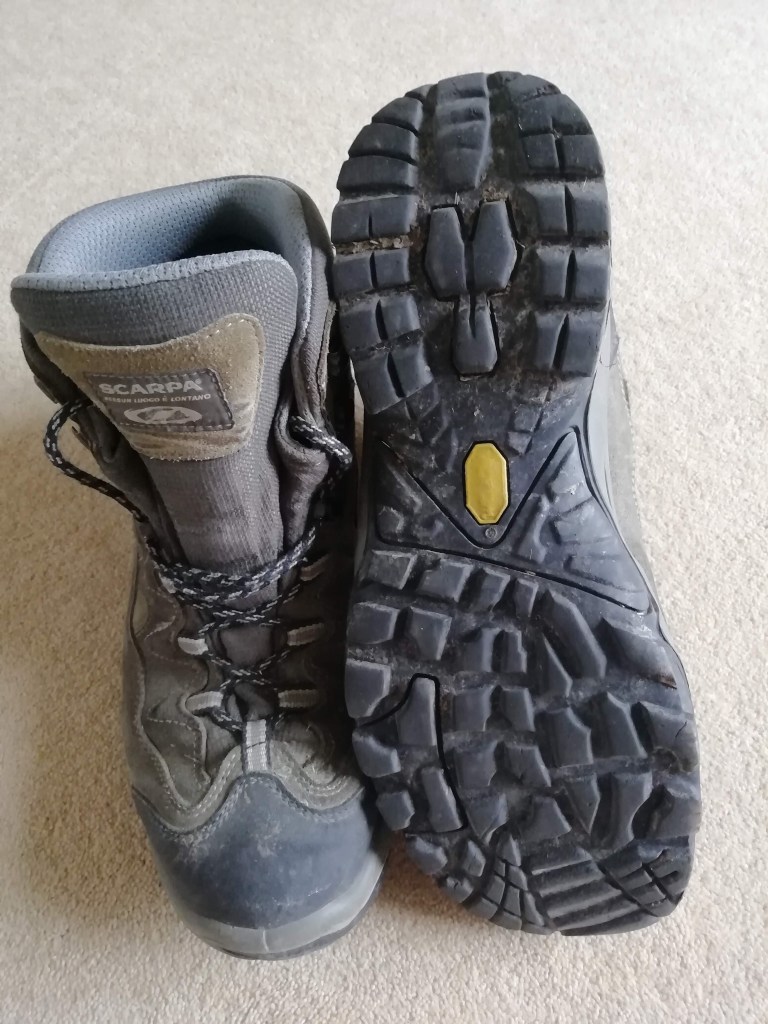
Low Level, Hill & Moorland Boots(B0)
The next level up from the approach shoe or cross trainer is a flexible lightweight boot. There are many makes and models that can be either cloth, synthetic or leather often with a waterproof lining. The sole units are either Vibram or own design and should provide an increased level of grip over an approach shoe.
Designed for use in hill and moorland environments where the boot can provide better foot protection on muddy wet ground and additional support on hills through the higher ankle cuff when compared to the approach shoe or cross trainer.
Pros – light flexible, comfortable from the box, improved support and weather protection.
Cons – Does not provide sufficient support or protection on very steep ground. Potential of feeling rocks and stone through the flexible sole. Lug pattern and sole stiffness not ideal for very steep ground.
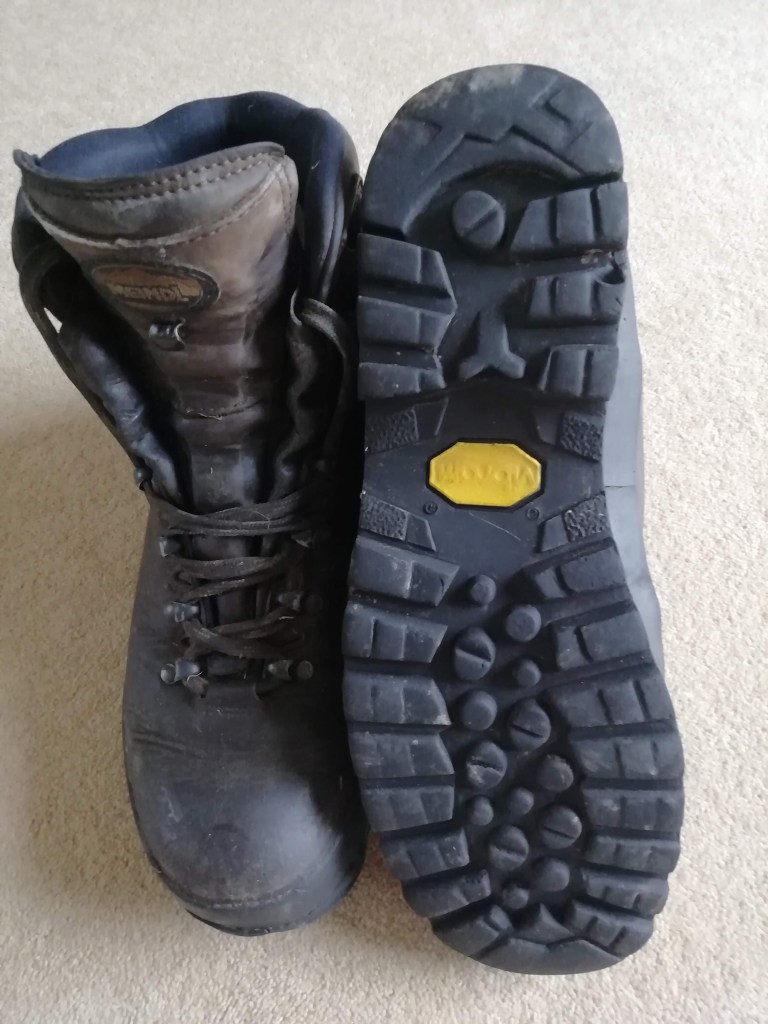
Three Season Mountain Boot (B0)
The entry level mountain boot with many makes and models available and can be either cloth, synthetic or leather often with a waterproof lining. Some will have a rubber rand to provide additional protection from stones and scree.
Sole units are either Vibram or own design and should provide a good level of grip on very steep ground and a small amount of stiffness. Also look for a defined heel step on the sole as this helps grip when travelling down steep slopes.
Pros – Comfortable from the box, good level of ankle support and weather protection.
Cons – Heavier by design when compared to a lower level boot.
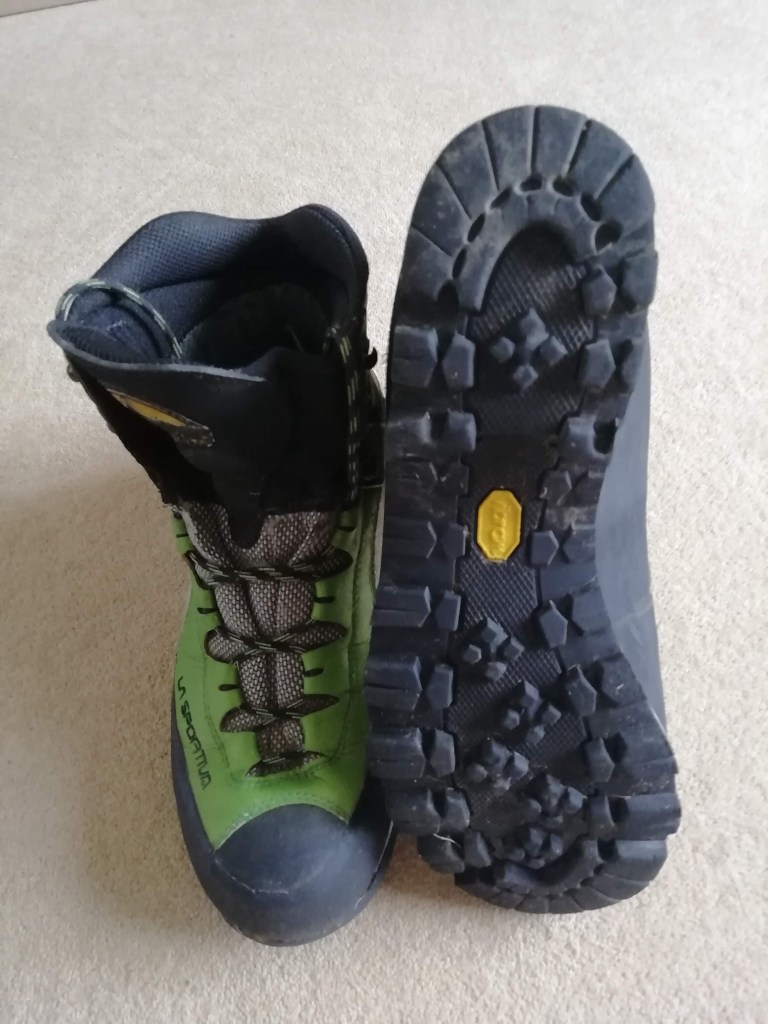
Three/Four Season Mountain Boot (B1)
Ideal for more adventurous UK mountains and summer alpine routes. Due to their increased stiffness they give more confidence on very steep slopes, scrambles and via ferrata. As they can be worn with a C1 crampon they can be used for occasional snow/glacier walking. There are many makes and models available and can be either cloth, synthetic or leather often with a waterproof lining. Most will have a rubber rand to provide additional protection from stones and scree.
The sole unit will normally be Vibram and should provide a good level of grip on very steep ground. The boot would be stiff enough so that it would be very difficult to bend. Like the Mountain B0 boot I would also look for a defined heel step on the sole as this helps grip when travelling down steep slopes.
Pros – Comfortable from the box, excellent level of ankle support and weather protection.
Cons – The stiffness may cause feet to become more tired. Not as warm as B2 or B3 boots so feet may become cold in winter conditions.
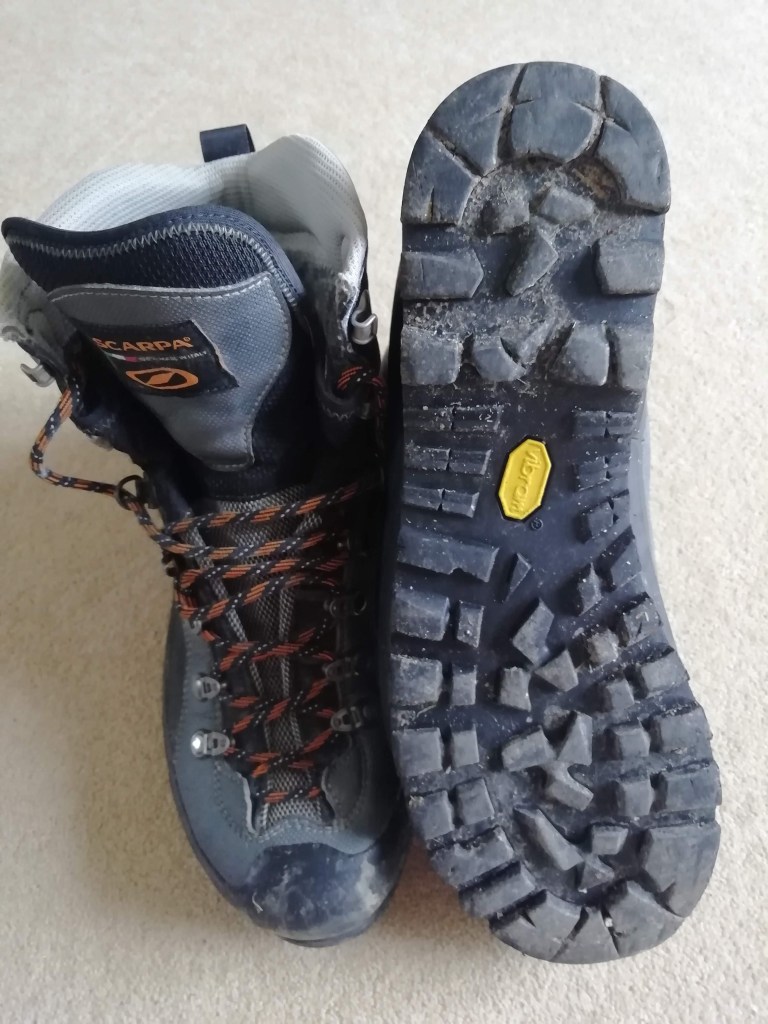
Four Season Mountain Boot (B2)
Ideal for winter mountain walking in the UK. They should have a very stiff sole and will accept a C2 crampon. There are many makes and models available, they can be either cloth, synthetic or leather often with a waterproof lining and all will have a rubber rand to provide additional protection when kicking snow steps.
The sole unit will normally be Vibram and should provide a good level of grip on snow and ice and have a rolling action to aid walking. The boot would be stiff enough so that it cannot be bent by hand.
Pros – Designed for winter mountaineering but can be used in other conditions due to the rolling action of the sole. Warmer than B1 boots with additional protection and stiffness.
Cons – May need to get accustomed to walking in them due to the stiffness, the addition of insoles like Superfeet may help to improve the walking action. Like the B1 boots the stiffness may cause feet to become more tired.
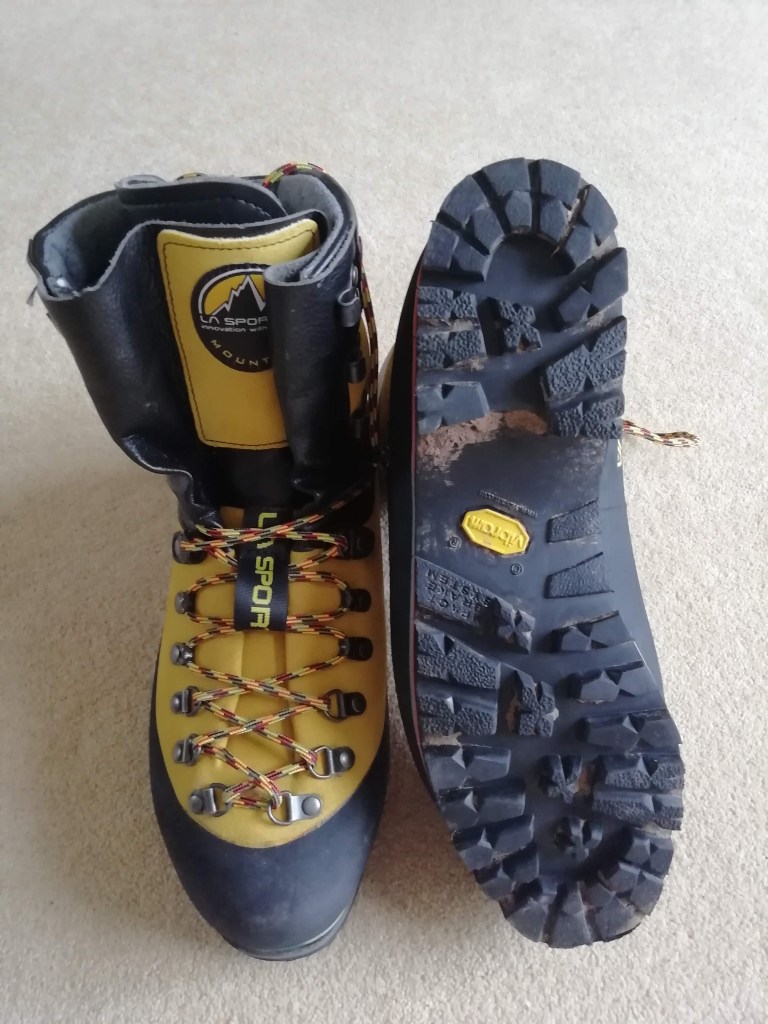
Winter Mountain Boot (B3)
Ideal for more adventurous winter mountain climbing in the UK and overseas. They should have a very stiff sole and should accept a C3 crampon. There are many makes and models available and can be either synthetic or leather often with a waterproof lining. All will have a rubber rand to provide additional protection when kicking snow steps.
The sole unit will normally be Vibram and should provide a good level of grip on snow and ice. The boot would be so stiff that it would be impossible to bend.
The boot will provide good ankle protection and support so that you can walk and climb on winter mountains with confidence and comfort.
Pros – Designed for tackling adventurous winter mountaineering climbing routes.
Cons – Most probably will need to get accustomed to walking in them due to the stiffness, the addition of insoles like Superfeet may help to improve the walking action.

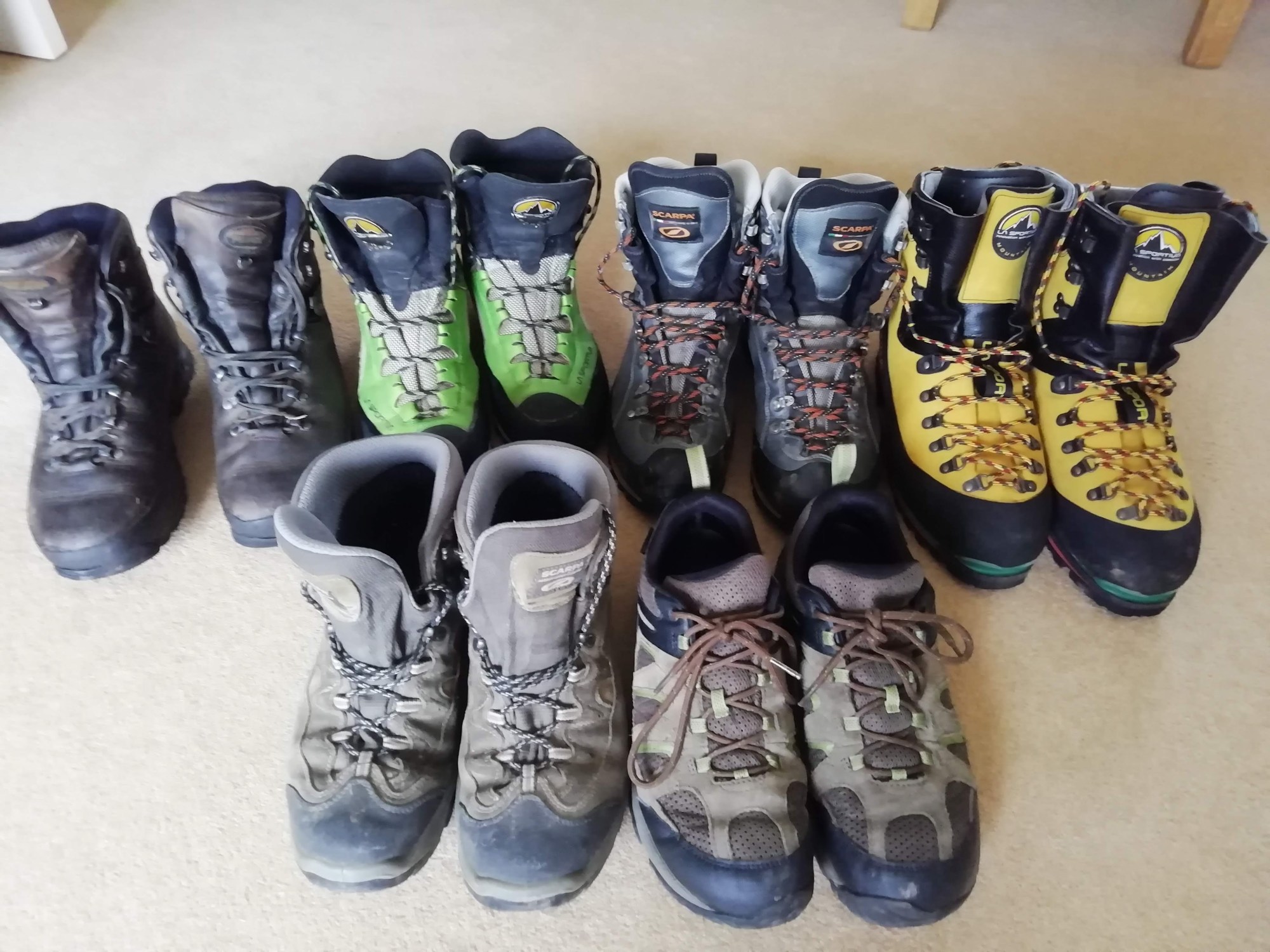
Thanks for ssharing
LikeLike